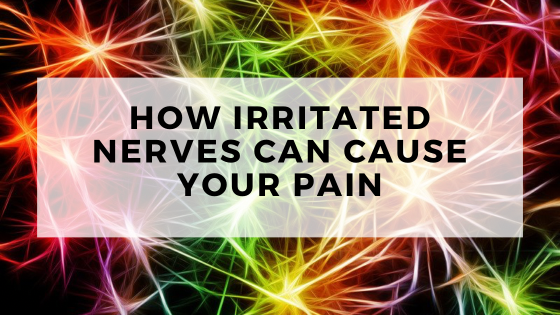Ever throw your back out? Once it happens, it seems like you’re more prone to it happening again and again. You might get a year or 6 months until it happens again… but it will. And then it will happen more and more. The research shows that ~40% of low back pain cases come from the Thoraco Lumbar Region involving the irritated cutaneous nerves. These are nerves that live close to the surface of our skin – most doctors don’t even realize these are a major source of pain. Let’s dive deeper.
How do nerves cause pain?
According to Dr. Lyftogt, many chronic pain conditions result from neurogenic inflammation. When a nerve becomes chronically inflamed, it can no longer establish the resting membrane potential of a healthy non-inflamed nerve. This leads to frequent and intense pain signals relayed to the brain by the inflamed nerve, resulting in perceived chronic pain.
Why doesn’t Advil or Aleve help my irritated nerves?
The thing about neurogenic inflammation is that it is not self limiting and things like Advil or Aleve do not calm it down. If you are always popping NSAIDs like Advil or Aleve and your pain is still present, then you likely have neurogenic inflammation.
The good news is that Glucose, a type of sugar can treat neurogenic inflammation very quickly and painlessly. Dr. Josh Hanson, DACM uses a simple 5% Dextrose injection around these irritated nerves to give them glucose – a type of nutrient to help them restart their healing process. If you want to get nerdy, here’s the detailed explanation of how this works.
These nerve trunks may contain up to 30,000 small fibers per mm2. Half of these small fibers are a variety of ‘pain fibers’, technically known as sensocrine or peptidergic nociceptors. These fibers are able to sense a large range of chemical, physical and thermal impulses and respond by releasing neuropeptides or neurohormones. This hormonal or endocrine function serves tissue homeostasis or steady state.
Under normal conditions the homeostatic or steady state function does not cause pain or inflammation. However when injured or irritated these peptidergic nociceptors are activated and thought to be responsible for painful conditions described as ‘neuralgias’ or ‘neuropathic pain’ or more commonly known as ‘chronic pain’. Peptidergic nociceptors are also able to detect high acid levels or acidosis and low glucose levels or glycopenia inside the nerves and respond by causing neurogenic inflammation and increased firing, perceived in the brain as neuropathic pain. Neuropathic pain is increasingly viewed as a homeostatic alarm signal indicating critically low levels of energy or glucose in the tissues and in peptidergic small fibers
Dr. Lyftoft, MD
Why didn’t my orthopedic doctor tell me any of this?
Truthfully, they just don’t even know this stuff exists because they don’t have a pill or treatment that they can bill insurance for. Because it’s not covered by insurance, most doctors just don’t even learn about it since they won’t get paid.
Dr. Josh Hanson, DACM takes a completely different approach – this is what makes his regenerative injection clinic so different. He is willing to learn any technique that might be beneficial to you.
What can I do for my irritated nerves?
If you’re in Tampa, FL then Dr. Josh Hanson, DACM has quite a few tools to treat irritate nerves. As we talked about in this article – a Perineural Injection of 5% Dextrose can be very helpful to treating irritated nerves. I also commonly use other tools like Acupuncture, Dry Needling & Prolozone Injections.
It’s always easier to treat a problem before it becomes a big issue – don’t wait any longer to get your irritated nerves under control.


